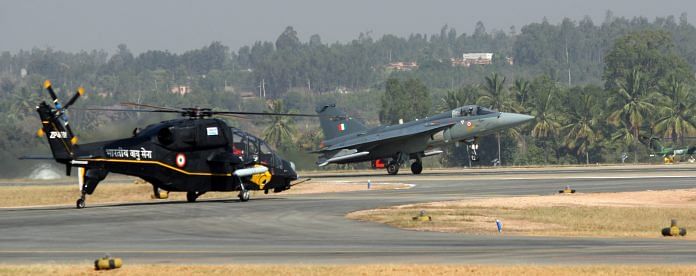A quick turnaround of the Tejas light fighter is on the cards but the government needs to step up.
It has been loved, hated, coveted, admonished and even ridiculed but for India’s homegrown combat aircraft, right now might just be the right time. The light combat aircraft (LCA) is the defence ministry’s lowest hanging fruit on the ‘Make in India’ path but it needs one final big push for which the government would need to step up soon.
Two things stand in the way of the fighter fully taking off as a potent symbol of the Indian defence industry – a strange interference by the Defence Research and Development Organisation (DRDO) itself and a painful obsession of the air force to diversify its fleet even further with a new, foreign origin single-engine fighter.
For a development programme that was sanctioned in 1983, the light fighter has come a long way. After limping its way through the 2000s, the single-engine jet has shown promise of late, maybe not as a cutting edge, globally competitive fighter but certainly as a platform that will enhance India’s combat capabilities within the region.
The desi fighter project is also one of the few things that the UPA and BJP governments have had a similar view on — the defence ministry under both regimes, driven by the person at the top, has been generous to overrule objections of the air force to give the Tejas time to mature.
A running battle between the air force, which insisted that the fighter is not good enough, and the defence ministry — batting for a homegrown jet to be accepted — came to head in 2015. Peace was brokered by then defence minister Manohar Parrikar on four simple terms.
That the air force would place orders for five squadrons of the fighter jet provided that four parameters are met — a world-class Active Electronically Scanned Array (AESA) radar to track targets, a long-range beyond visual range missile, air-to-air refuelling capability to enhance range and modern electronic warfare capability for survivability of the aircraft.
The deal was simple — meet these four requirements and the air force would have no choice but to place orders, giving the jet a fighting chance of proving its combat capability.
While progress has been made at various levels on integrating these four enhancements, DRDO itself, which has been deeply involved in the project, has come as a possible hindrance. Scientists have placed on record strong protests over efforts by Hindustan Aeronautics Limited (HAL) to purchase new radars and electronic warfare systems from the global market. The logic? That these systems can be developed in India if the funds are allocated.
Given the tight timeline in which they need to be integrated and proven on board the Tejas — by 2020 — the best case scenario is to purchase the radars and systems from the global market and replace them subsequently with a homegrown solution when it matures.
However, with DRDO’s objections on record, it would take a strong stand by the defence ministry to do the right thing and honour the deal brokered in 2015. The question to be answered is whether the defence ministry is willing to bite the bullet to get the LCA truly off the ground.
The other challenge for this true ‘Make in India’ programme is the new-found foreign origin single-engine fighter jet obsession of the air force. The air force wants to buy several new fighter jets in the coming years.
The Rafale order has already been placed with a possibility of many more, a fifth generation fighter from Russia is on the cards but to further make up for numbers, the air force has moved a proposal for 118 new fighters — to be assembled in India. By specifying that it only wants jets with a single engine, only two jets in the world meet this requirement — the American F-16 and the Swedish Gripen.
By going with this ‘single engine’ formula, the air force is, in fact, contradicting itself. Years ago, when it started the now infamous Medium Multirole Combat Aircraft (MMRCA) competition, it was specified that the capabilities of a fighter would be judged — speed, range, weapon delivery, survivability etc — and not the number of engines it is equipped with. This gave way to the selection of the Eurofigher and Rafale as technically compatible fighters to Indian requirements, rejecting both the F-16 and the Gripen.
The fact is that a third single-engine fighter jet choice is now available for India — an improved, spruced up LCA that will be the precursor to a full range of homegrown combat aircraft.
And this might well be the most viable option.




Wow!! Great. Does this mean both Saab and LM have realised their junk will not be coming to India without TOT?
Actually tejas would have in service long back but the corrupt donkeys in north block and south block have eyes on the peice of shit thrown by the dalals and aviation companies , now this govt have overcome all these greedy people and tejas will be inducted finally